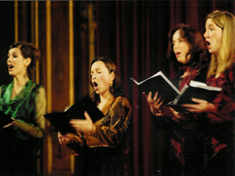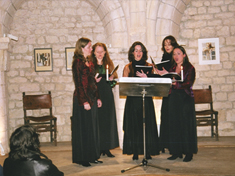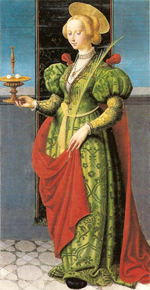

The vocal ensemble KANTIKA is specialized in mediaeval
repertoire. Kantika has contributed to the revival of the music
from this period by the lively interpretation of their singers,
each with her own personality and artistic potential.
Concerts invite the listeners to a journey into the past, into
the universe of a mediaeval monastery, a cathedral or a royal
court where time flowed more slowly, according to different
rhythms where one sang incessantly the praises of God and Love.
KANTIKA connects both, a historical approach to the original
manuscripts and a vocal research enriched by each singer’s
personal background. Sacred music is performed in its liturgical
context, the historical order of the office being respected.
Different versions of the same chants are compared; later
versions notated on lines help to read the older ones. All our
programmes are performed from facsimile editions.
Although the ensemble never exceeds chamber size, for some of
our programmes, we invite different musicians playing the lute,
the rebec, flutes or percussion instruments.
In the years to come, KANTIKA wants to continue their
co-operation with contemporary composers; this started in 2005,
with the first commissions by Thierry Machuel, Pascal Diez and
Hans van Zijp. In 2006, the film music composer Jean-Michel
Oberland made an arrangement of an extract from Carl Orff’s
Carmina Burana. This year the Swiss composer Caroline Charrière
writes a new piece for the ensemble.
PROGRAMMES
KANTIKA proposes almost a dozen different programmes with
mediaeval music from 11th century Gregorian chant to court
chants from the 14th century: « A summo celo » - Gregorian
chants from Saint-Martial of Limoges, « Lux » Lucy’s Mass/
Chants from the Apt Cathedral (11th – 14th century). The
concerts can be mixed with one or two contemporary pieces or
literary texts from the Middle Ages. A concert with mediaeval
music and fairy tales has been conceived for young audiences.
« A summo celo » - Gregorian chants and polyphonies of
Saint-Martial of Limoges (11th-12th c.)
Embertide is an old tradition of the Roman Church. Four times a
year, at each new season, three days of the week were devoted to
fasting and praying.
The mass bears the traces of a very ancient liturgy. Its
numerous lectures amidst chants and prayers evoke the primitive
form of nocturnal vigils in Rome; the texts of the Mass of the
Embertide can be interpreted as an announcement of the liturgy
of Christmas.
Gregorian chants come from an 11th Century manuscript from
Saint-Yrieix. The tropes, famous genre in this repertoire, and
the polyphony were taken from two manuscripts of 12th Century
Aquitania.

sainte Lucie |
« Lux »
Saint Lucy’s Mass / Gregorian chants and polyphonies
from mediaeval manuscripts from the Apt cathedral (11th
– 14th c.)
Sancta Lucia : Mass for the nativity of Saint Lucy. The
cathedral of Apt possesses almost forty mediaeval
manuscripts, including some liturgical books from the
11th to the 14th century, a troper, a gradual and a
polyphonic collection. Their different musical notations
allow us to follow the evolution of musical writing in
the Middle Ages and to give a renaissance to this music
in its original historical environment. |
Commissioned Works
2005
Thierry Machuel, « Piececitos » for 4 women’s voices
Hans van Zijp, « Ignis est invisibilis » for 3 women’s voices
Pascal Diez, « La Table d’Emeraude » for 3 women’s voices
2006
Carl Orff/ Jean-Michel Oberland, « Veris leta facies » (Carmina
Burana) for 4 women’s voices and percussion
soon
Caroline Charrière, « Lumen » for 5 women’s voices
|















